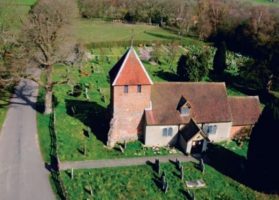Family
Frederick Theodore Freeman was born on 25 June 1887 in Burghfield, Berkshire.
His parents were Benjamin and Louisa Freeman (née Blake).
He was the youngest of seven children: Henry William, Albert George, Louisa Jane, Benjamin Robert, Susan Eliza, John Ernest, Frederick Theodore.
An 1887 Trade Directory for Berkshire records Benjamin Freeman at the ‘Swan Inn’, Burghfield Bridge, which would suggest that Frederick was born there. In the 1891 census the ‘Swan Inn’ is the entry next to ‘The Cunning Man’ (a beer house) at Burghfield Bridge and Benjamin is recorded as both publican and blacksmith. The bridge crosses the Kennet and Avon Canal. In such a location there would undoubtedly have been plenty of trade in shoeing the horses which pulled the barges along the canal.
In the 1901 Burghfield Census Frederick was aged 13 years and still living at the ‘Swan Inn’ where his father was still listed as a ‘Blacksmith’.
In the 1911 Pamber Census, aged 23 years, Frederick is still listed as being a ‘Blacksmith’. He, his mother and Benjamin junior (also listed as a ‘Blacksmith’), are recorded at Pamber End, presumably in ‘Forge Cottage’, on the corner of the Bramley Road, opposite ‘The Queens College Arms’. His mother is, by then, a widow, Benjamin senior having died in October 1910.
Frederick married Amy Norris on 22 May 1915 at Pamber Priory Church. At this time he gave his occupation as ‘Postman’. At the time of Frederick’s death, Amy was living at Tadley Hill. To our knowledge they had no children.
Service record
Frederick enlisted in Basingstoke on 10 December 1915. He was based in England until 26 September 1916 when he went to France to join the British Expeditionary Force. Once there he was part of the army pool. He joined the Royal Garrison Artillery on 24 February 1917, becoming a fitter gunner with the 94th Siege Battery (service number 87176) on 7 July 1917. Presumably his trade as a blacksmith equipped him well for such a position.
The 94th Siege Battery was formed in Tynemouth in December 1915. 40% of its personnel consisted of Regulars and New Army men from the Tynemouth Royal Garrison Artillery, the remainder were Territorials from the Durham Royal Garrison Artillery (West Hartlepool).
The battery went to France in May 1916 and subsequently fought on the Somme (1 July – 18 November 1916), at the Battle of Arras (9 April – 16 May 1917) and the Battle of Messines (7-14 June 1917). On 27 June the battery proceeded by road to Oost Dunkirke on the Belgian coast and by 4 July the guns were in operation.
Planned offensive operations were stalled by a successful enemy attack on 10 July. During the succeeding weeks the battery was involved in an artillery dual with the enemy defending the coast and Ostend which resulted in heavy casualties. On the night of 10-11 July the battery’s ammunition dump was set on fire by enemy shelling and in a few minutes the conflagration extended to nearby small barns filled with gun stores. Only due to excellent work by the men did they succeed, in spite of burning and exploding ammunition, in salvaging some cartridges and gun stores and getting the fire under control.
During this period casualties were high. Concealment of guns amongst the sand dunes was particularly difficult, necessitating the battery moving to three different locations in the area to avoid enemy shelling. Frederick was injured on 15 September, towards the end of this artillery dual and died the following day.
Died
Frederick died on Sunday 16 September 1917, aged 30, at a casualty clearing station from wounds received the previous day.
Commemorated
He is buried in Zuydcoote Military Cemetery [I. B. 30], Zuydcoote, Nord, France.
He is also remembered on Tadley War Memorial and on the Pamber Priory Church Memorial.
Decoration
Frederick was awarded the Victory medal and the British War medal. These would have been sent to his wife.

